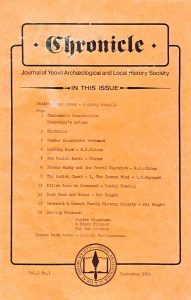1978-Sep-pg6-7_Looking Back
This article came from the Chronicle published September 1978. Pages 6-7
LOOKING BACK
Author: Edgar Silcox
Many prehistoric and Roman sites were known in the Yeovil area, but little organized investigation took place until the formation of the Yeovil School Archaeological Society by the School History master, Leonard Hayward in 1945. Many years before this R.Walter of Stoke-sub-Hamdon had carried out work on Ham Hill, reported in Vol.IV of the County Society’s Proceedings in 1853. This work was continued by Dr.W.W.Walter in 1889 at the foot of Ham Hill and later, in 1906, by Dr,R.H.Walter. Further work on the history of the locality is recorded in Vol.XXII of the Proceedings, 1886. And of course, there was the excavation of the Roman villa complex near the Westland works, completed in 1928 and reported in Vol.LXXIV (1928) of the Proceedings.
In 1945 the new School society set to work on a site at Lufton, noticed by X.J.C.Hill and L.Walrond, the latter now the Curator of Stroud Museum. This Roman villa was excavated between 1946 to 1952 and again from 1960 to 1963. In between these two periods an important event in Yeovil was approaching – the centenary of the incorporation of the borough. The Town Council appointed a Celebrations Committee which organized an exhibition of local history at Hendford Manor Hall, now the Museum, from 3 to 10 July 1954. Over a hundred items on show gave a wide range of information on the town’s past. In connection with this a town history was compiled by E.A.Batty, Borough Librarian, John Goodchild, editor of the ‘Western Gazette ’, and Leonard Hayward.
Was this the right time for the formation of a sooiety interested in archaeology and local history? Leonard Hayward thought so. He called a meeting at Yeovil School of people known to be interested in October 1954 which resulted in the formation of the Yeovil Archaeological Field Club, with Mr Hayward as Chairman, and a Committee of E.A.Batty, J.Stevens Cox, C.Tavender and the writer: the present Chairman, Isabel Rendell joined the committee in the following year.
The new society set out to investigate possible sites for excavation in the surrounding area and to publish the results of such work; to organize, meetings, lectures, and discussions; to arrange excursions and any other activities which might further the aims of the Club, which in 1959 amended its name to its title today – Yeovil Archaeological and Local History Society.
During the 24 Years of the life of the society 150 winter lectures have been given and 159 summer excursions arranged: the summer meetings included 41 coach trips. From its inception the society has been affiliated to the Somerset, Archaeological and Natural History Society and with the Council for British Archaeology. Of the many speakers who gave lectures Professor Gordon Childe, Professor Barry Cunliffe, E.Clive Rouse, Philip Ratz, E.J.Kelting, H.St.George Gray, Leslie Alsock, Dr.J.H.Bettey, Dr.R.Denning, come to mind. Visits made include every city within seventy miles, except Bath, usually each being organized as a guided tour: towns in the same area range from Tiverton in the West, to Lymingson in the East, and from Tewkesbury down to Portland.
The most important digs undertaken were the Lufton Villa and Ilchester Mead, both directed by Leonard Hayward. Other sites investigated were at Blackford (the Bishop’s Palace, by Isabel Rendell), Nash Lane, West Coker Roman villa. and Collaton Park, Dorchester, the last three directed by G.Aitken. But the society has been involved in other excavations in that it has backed work by other investigations, notably Roger Leach at Catsgore, near Somerton, with financial help from the Morland Trust. Members, too, have helped in numerous sites throughout the area, particularly on the by-pass excavations at Ilchester and Wincanton and at other works carried out by Committee for Rescue Archaeology in Avon Gloucestershire and Somerset (CRAAGS)1 (see below)
But in its home town, Yeovil, less well-known work has been carried out over many years. A group of members meet weekly at the Museum where there is always work to be done. The Museum’s collection of photographs has been transferred to slides and is to be augmented by the addition of the work of T.J.Cave, a valued honorary life member of the Society. In addition over the years, the committee, led by its Chairman Leonard Hayward, has kept a watchful eye on building developments with a view to protecting worthwhile buildings.
Officers of the society include Leonard Hayward, the founder and chairman until three years ago when he was followed, as mentioned above, by Miss Isabel Rendell. Secretary-treasurers M.Jones, V.Platt, Mrs. G.Aitken and the writer, who was succeeded last year by the present secretary W.T.J.Chapman. Various new activities are, it is believed, being undertaken, one of which is the publication of the journal in which this article appears. This venture is in the experienced hands of Leslie Brooke, author of the recently published ‘Book of Yeovil’ which has met with well-earned success. Committee members have been numerous., but some long-serving members should not be overlooked: Russ Clynick, the late T.P.Sandford, Malcolm Lindley, Sir Robert Hall, now living in New Zealand who began important work on medieval small houses, which work is being continued by L.C.Gilson.
Perhaps the finest undertaking of the Society was ‘Symposium 76’ held at Yeovil College in March 1976. This whole-day meeting was held in conjunction with Yeovil and District Natural History Society: eight authoritative speakers were engaged, and 184 tickets were sold.
Membership of the Society is now over 80. With plans for expansion now under way its success in its second quarter century must be certain.
Reference:
1. Committee for Rescue Archaeology in Avon Gloucestershire and Somerset (CRAAGS)
